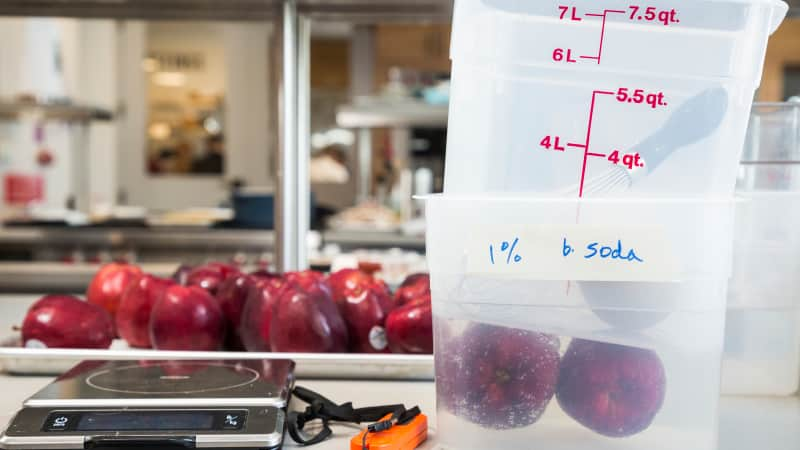We all know pesticides can remain on conventionally grown produce. For those of us looking to minimize exposure to such chemicals, is there a reliable way to remove them from fruits and vegetables?
Can Baking Soda Remove Pesticides from Produce?
Published May 25, 2023.

A 2017 study conducted at the University of Massachusetts found that washing produce in a baking soda solution can make a real difference: just a 15-minute soak in a 1 percent baking soda solution, followed by a rinse in clean water, completely removed two common pesticides from the surface of apples. (Some pesticide remained inside the peel; more on that below.)
Sign up for the Cook's Insider newsletter
The latest recipes, tips, and tricks, plus behind-the-scenes stories from the Cook's Illustrated team.
This sounded like an easy and promising method for at least getting rid of pesticides on the outside of produce, but we wanted to run our own tests, comparing a baking soda wash to other common methods for cleaning produce.
Our Cleaning Tests: Baking Soda vs. Vinegar vs. Tap Water
We purchased pesticide detection cards that can ascertain the presence of two types of commonly used pesticides—carbamates and organophosphates.
A detection card is dipped into a solution in which the fruit has been soaked, and then pressed against a second card. If that second card stays white, it indicates a high concentration of pesticide residue. But if the disk turns blue, this indicates very little to no residue.
For our tests, we chose grapes, which have a lot surface area for harboring pesticides.
First, we used the cards to confirm that there were indeed pesticides on the surface of then grapes. Then we conducted the following tests:
- Soaking in baking soda solution: We submerged some of the grapes in 2 teaspoons baking soda plus 1 quart water (roughly the same formula used in the original study) for 15 minutes.
- Swirling in baking soda solution: We swirled another batch in the same solution for 30 seconds.
- Soaking in a vinegar solution: We misted more grapes in a solution made up of 3 parts water to 1 part vinegar.
- Rinsing under cold running water
We rinsed the grapes in water after treating them with each of the solutions, and dried them all before checking for pesticide residue with the detection cards.
The Winner: Baking Soda
Only the test cards applied to grapes treated with baking soda solution turned blue, indicating that it was effective at removing pesticides.
How Does Baking Soda Remove Pesticides?
Because most pesticides aren’t stable at an alkaline pH, soaking them in a baking soda solution can break down their compounds, and together with a rinse under tap water, can help to wash them away.
Note: The baking soda solution will remove only certain classes of pesticides, and only from the produce’s surface. Spray pesticides that are designed to be absorbed cannot be rinsed away; neither can those that are applied to a plant’s roots. (In the University of Massachusetts study, one of the pesticides applied to the apples, thiabendazole, was designed to be absorbed by fruit flesh, and 20 percent of it remained in the peel after the baking soda soak. In addition, 4.4 percent of a second pesticide, phosmet, which is designed to stay on the surface, also penetrated the peel and remained after the soak.) But since baking soda does such a good job of removing some common types of pesticides from the outside of produce, and because the method is fast and easy, we’re still inclined to use it.
Vegetables Illustrated
The best-selling cookbook for anyone looking for fresh, modern ways to add more vegetables to their everyday diet. Covering 70 vegetables, Vegetables Illustrated has you covered for every vegetable and every season.How to Wash Fruit and Vegetables with Baking Soda
Swirl produce in a solution of 2 teaspoons baking soda per 1 quart water for 30 seconds (the produce should be submerged by at least 1 inch of liquid), and then rinse under cold running water.

